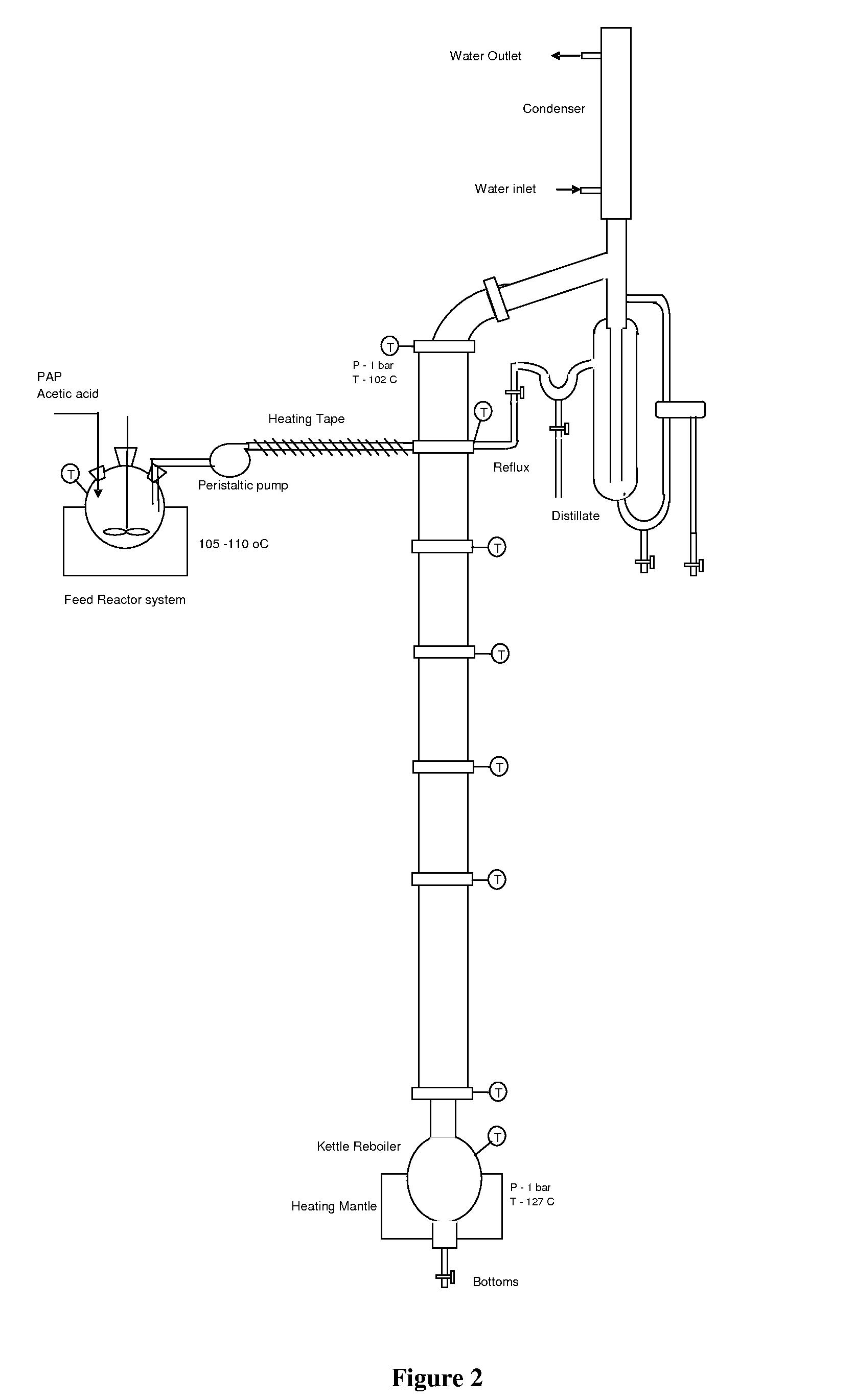Reactive distillation process for preparation of acetaminophen
- Summary
- Abstract
- Description
- Claims
- Application Information
AI Technical Summary
Benefits of technology
Problems solved by technology
Method used
Image
Examples
example 1
[0111]In a batch reactor, acetic acid (150 g) was heated to 60-80° C. At that temperature para-aminophenol (100 g) was charged in about 5 to 10 minutes. The mixture was then rapidly heated to 115 to 120° C. over 15 to 20 mins. The reaction was allowed to continue up to 3 hrs. At this stage conversion of 90% was obtained. On further continuation of reaction up to 8 hrs a conversion of >99% was obtained. 120-200 ml of water added for dilution of acid. Reaction mass is then cooled to 10-30° C. for 4 to 7 hrs, crystallized mass was filtered to get the tech paracetamol. The yield of Tech Para is 1.22. Charcoalization of techpara was done by adding 200-500 ml of water and activated carbon of 1-4% of technical mass and heating up to 70-95° C. and maintained for 15-60 min. Activated carbon is filtered and mass is cooled to 5-30° C. over 5-10 hrs. Crystallized mass filtered to get the pharma Paracetamol with LOD of 5-8% dried to <0.5% LOD. The yield of 1.15 to 1.17 is achieved.
[0112]Tech ML ...
example 2
[0113]In another example, the batch reactor is assembled with a distillation packed bed. Acetic acid (150 g) was heated to 60-80° C. At that temperature para-aminophenol (100 g) was charged in about 5 to 10 minutes. The mixture was then rapidly heated to 115 to 120° C. over 15 to 20 mins. The vapor containing water and acetic acid evolved during reaction is sent to the attached distillation column. The water rich overhead stream is collected in a vessel. The bottom stream rich in acetic acid is returned to the reactor. Water removal helped to achieve 90% conversion at reduced time of 2 and half hours. On further continuation of reaction in same manner up to 6 hrs a conversion of >99% was obtained. 120-200 ml of water added for dilution of acid. Reaction mass is then cooled to 10-30° C. for 4 to 7 hrs, crystallized mass was filtered to get the tech paracetamol. The improved yield of Tech Para is 1.26. Charcoalization of techpara was done by adding 200-500 ml of water and activated ca...
example 3
[0114]Para-aminophenol (100 g) and acetic acid (250 g) were heated to 60-80° C. in pre-reaction vessel and fed to the reactive distillation column at 2 to 30 ml / min flow rate. Column top and bottom temperatures were maintained at 100 and 120° C., respectively. Conversion of 85 to 99% conversion is achieved. 100-180 ml acetic acid recovered from bottom reaction mass and 120-200 ml of water added for dilution. Reaction mass is cooled to 10-30° C., crystallized mass filtered to get the tech Paracetamol. 200-500 ml of water and activated carbon of 1-4% of technical mass are added to technical material and temperature is raised to 70-95° C. and maintained for 15-60 min. Activated carbon is filtered and mass is cooled to 5-30° C. over 5-10 hrs. Crystallized mass filtered to get the pharma Paracetamol with LOD of 5-8% dried to <0.5% LOD. The yield is achieved in the range of 1.15 to 1.24
[0115]Tech ML and Pharma ML are concentrated to 40 to 90 wt % solids by evaporation of acetic acid and w...
PUM
| Property | Measurement | Unit |
|---|---|---|
| Fraction | aaaaa | aaaaa |
| Fraction | aaaaa | aaaaa |
| Fraction | aaaaa | aaaaa |
Abstract
Description
Claims
Application Information
 Login to View More
Login to View More - R&D
- Intellectual Property
- Life Sciences
- Materials
- Tech Scout
- Unparalleled Data Quality
- Higher Quality Content
- 60% Fewer Hallucinations
Browse by: Latest US Patents, China's latest patents, Technical Efficacy Thesaurus, Application Domain, Technology Topic, Popular Technical Reports.
© 2025 PatSnap. All rights reserved.Legal|Privacy policy|Modern Slavery Act Transparency Statement|Sitemap|About US| Contact US: help@patsnap.com



